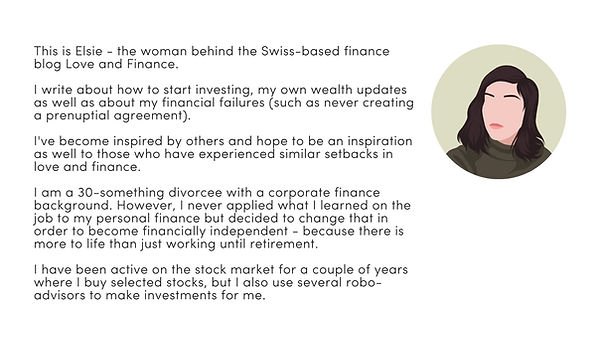inyova Half-Year Portfolio Review
- loveandfinance

- Jul 13, 2021
- 3 min read
Updated: Oct 16, 2021

It's time to have a peak at my inyova portfolio and see how it is doing. We are now mid-way past 2021 and what a turbulent year it has been, both personally and financially. I check on my inyova account at least weekly (hop on over to my instagram and check my stories nearly every Friday evening), and now I'll have a year-to-date snapshot for 2021.
I've had my inyova account since October 2019, but only had the minimum deposit in there and barely even looked at it. It wasn't until earlier this year, that I arranged for monthly automatic transfers and other ad-hoc transfers whenever I had some extra cash laying around. Now I transfer at least CHF 200 every month.
As of June 28, 2021, my inyova account has generated an unrealized gain of CHF1,687 with a net performance of 34.7% since opening the account. Since the beginning of 2021, nearly a third of this unrealized gain was generated this year alone.
As you can, since 2019, there is an obvious upward trend of accumulating gains, even though March 2021 shows a significant dip. Any losses made in March 2021, have already been made up until now. This shows the value of long-term holding onto your investments without panicking when the markets may be down. In fact, I should have immediately invested more in March so that inyova could have my purchases on sale! Well, lesson learned: with a long-term outlook, buy the dips!
Zooming in for 2021, you can see it was indeed a turbulent year, although my gains seemed to going mainly sideways, maintaining an average of nearly 5% increase year-to-date.
inyova also gives me a nice graph of how much I can expect my portfolio to increase if I do not deposit any further amounts into it for the next 20 years. Compounding interest truly is amazing!

Within my portfolio, my "impact topics" are renewable energy, local companies and clean water and I exclude companies which deal with alcohol, tobacco, nuclear or weaponry. inyova invests directly into companies for me (rather than "only ETFs"), which, along with a focus on sustainability, I think it's also inyova's unique selling proposition compared to other robo-advisors. Click on details, and you can see more details about the underlying company that you invest in.

You can find my first experience report of inyova here. If you want to give inyova a try, simply use my inyova invite code 9286d and get the 6 months managed for free!

Why I don't disclose all hard figures:
Although it is super fun to run the numbers and compare them on a regular basis and sharing them with you all my money successes and failures, I don't share my hard figures. This is mainly because I don't want to engage in any comparison games (a la "comparison is the thief of joy"). Occasionally, when I browse other financial blogs or instagrams, it can be quite overwhelming when large numbers are posted -- a bit of jealousy could creep in. So, I've decided to give percentages in my portfolio updates and most of my other posts, because it's not about trying to compare my money journey to yours or theirs; these blog posts are meant to 1) keep a simple record for myself and 2) inspire you to start tracking your own net worth and other metrics without the pressure of keeping up with anyone.
++This is not financial, legal or investment advice and is not a solicitation to buy or sell products. I assume no liability for the accuracy of the information on my website, blog articles and any emails. Trading securities on the stock market is risky and you could lose your entire initial investment. I assume no liability for your decisions. I recommend products on my blog that I use myself. I may receive a commission for links posted, which helps me finance my blog and website.++








.png)
.png)
.png)
.jpg)
.jpg)
Hi there, nice blog, however there are a couple of correction to be made. 1) you disclose the absolute value (both in "saying the unrealized gain + net performance" and in "estimated asset development") 2) The "estimated asset development" is calculated assuming that you invest the monthly amount you set in your strategy. It is less a magic of compound investment and more the algebraic sum of your monthly investment plus some interest: have a look at the bad case, where you have ~50k in 2041 after 20 years. If you invest for 20 years (= 240 months) 200 chf per month + the initial investment of ca. 2k, the sum is ... ;) at least with the bad case yova expects…